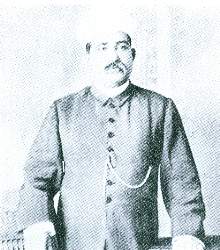 Shams-ul-Ulama Syed Au Bilgrami was a distinguished scholar and a linguist. His ancestors came from Mesopotamia, situated between Baghdad and Basra. His grandfather was a representative of the King of Oudh at the Viceroy’s Court.
Syed Au Bilgrami was born in 1851. Graduated from the Canning College, Lucknow. Sir Salar Jung I who was always on the look out for able men invited Au Bilgrami to join the Nizam Government service. He served the Nizam’s Government in various capacities: Director of Public Instruction, Home Secretary, Inspector General of Mines and Secretary, Public Works Department.
Shams-ul-Ulama Syed Au Bilgrami was a distinguished scholar and a linguist. His ancestors came from Mesopotamia, situated between Baghdad and Basra. His grandfather was a representative of the King of Oudh at the Viceroy’s Court.
Syed Au Bilgrami was born in 1851. Graduated from the Canning College, Lucknow. Sir Salar Jung I who was always on the look out for able men invited Au Bilgrami to join the Nizam Government service. He served the Nizam’s Government in various capacities: Director of Public Instruction, Home Secretary, Inspector General of Mines and Secretary, Public Works Department.
Syed Au Bilgrami was a very able administrator and was a fellow of the Geological Society of London. He was also a great author and among his books which may be mentioned are “Monograph on the Book of Kalila and Dama”, “Relative merits of the study of Persian and Sanskrit”. He ranslated Athrva Veda. Au Bilgrami was well versed in Sanskrit.
In 1891, the Government of India gave him the title “Shams-uiU lama” which literally means “Light of the Learning”.
yed Ahmed Hussain whose nom-de-plume was Amjad belonged to a respectable middle class family of Hyderabad. The exact date of his birth is not known. It was probably 1888.
Forty days after he was born his father died. His mother was left helpless and brought him up in utter poverty.
Amjad received his early education in Madrasa-e-Nizamia and qualified as Munshi Fazal from Dar—ul-Uloom and later found employment in the same school. Afterwards he secured a job in the Accountant General’s office from where he retired as Assistant Accountant. In the disastrous Musi floods of 1908, Amjad lost his mother, wife and daughter, he himself escaped by sheer chance.
Six years after this tragedy, Amjad married the daughter of his teacher and gave his wife Jamalunisa a new name, Salma. He wrote an account of his life with Salma and published it under the title “Jamal-e-Amjad”. Amjad turned to poetry at the early age of 15 or 16. The first poem that he wrote at the age of 24 was titled ‘Man and the world’. He wrote several gazals and recited them. Gazal in fact was not a form that suited Amjad’s taste. The real poet emerges in the quatrains (Rubiath) that he wrote all his life.
In his quatrains Amjad used religious, mystical, ethical and spiritual themes. Amjad’s fame as a poet rests entirely on his ‘Rubiath’. The first collection of 100 quatrains was published in 1907. In 1933 Maulana Syed Suleman Nadvi paid a high tribute to Amjad as a poet and gave him the title of “Hakeem-us-Shaura” (the wise poet). In 1955 Idara-e-Adbiat Urdu celebrated the poet’s diamond jubilee. On this occasion the famous poet Josh Mallihabadi, in spite of differing strongly from Amjad’s creed paid him the highest compliments.
Amjad was the author of 15 books of prose and verse. He died on 29
March, 1965.
|